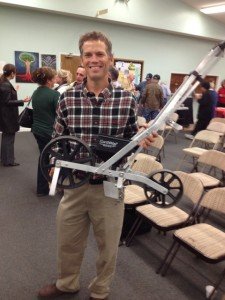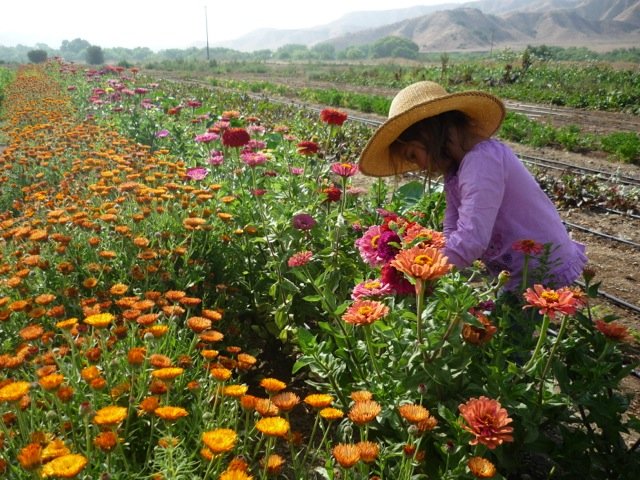Another great talk — by Abby Harned from Three Sisters Farm in Redlands CA — at our Redlands horticulture meeting last night. (One advantage of being program chair is you get to invite wonderful speakers.) We learned first-hand how an organic farm is set up, and how they attract natural predators –insect and mammals that include coyotes and weasels — to take care of pests. They also plant rows of native plants and pollinator-attracting plants that provide habitat for beneficial insects. It was obvious that Abby and her husband, Jason, really love what they do.
Here are some takeaways from her talk:
We love coyotes because they’re our natural control for squirrels, rabbits and gophers. We want the snakes and the bobcats, even the mountain lion.” Abby Harned, Three Sisters Farm

- Compost is key: They use horse manure mixed with wood shavings, to which they add garden waste, and turn five times in 15 days for a rich compost. Also, rock dust, which is ground rock that provides the building blocks of soil, provides trace minerals.
- Say no to monoculture: They grow 20 to 30 different crops (all non-GMO as are all organic crops) on the one acre of their 20 acre farm, so they don’t rely on any one crop in the rare case one fails. “Because we don’t rely on just one crop, we haven’t needed to use organic approved pesticides for the times pests have been a problem,” says Abby.
- Attract and use natural predators when possible: Their primary pests are aphids along with the troublesome African black beetle that has evaded natural predators as it devastates brassica plants. “We attract natural predators, both invertebrates and mammals. We love coyotes because they’re our natural control for squirrels, rabbits and gophers. We want the snakes and the bobcats, even the mountain lion,” says Abby. In addition, barn owls and great horned owls use raptor perches on the farm every night. For the wild boars in San Timeteo Canyon, well, Abby says their two large dogs have kept them away. See my previous post on predator friendly farms and products.
- Native plants attract beneficial insects: The Harneds have restored their land with California native plants such as toyons, elderberry, wild cherry (some of my favorite plants). “We call these ‘aviary on a stick’ because the berries attract the birds, which then stay around to eat the bugs,” Abby says. They also plant sunflowers, and plants such as yarrow, parsley to attract beneficial insects such as a wild wasp that eats caterpillars. (I’ve written many posts on natives and wildlife – here’s one.)
- Chickens on moving tractors: After they lost a couple chickens to predators, they built two chicken tractors that house the chickens as they move along the crop rows. “Their droppings fertilize and they debug the soil, eating insect eggs and weeds — and there are plenty of those,” says Abby.

Jason Harned and his favorite planting tool (which cost $100 but “it’s worth $1000.”) Eliot Coleman’s The New Organic Grower was the book they relied on to learn about how to lay out the farm and the best tools, along with their agronomy and irrigation sciences degrees. They use planting tools and prefer smaller tilling equipment, which leads to less rototiller use that is hard on earthworms.
- Support your local CSAs (Community Supported Agriculture). Three Sisters sells at one of our local farmers market, but I wasn’t aware that they sell a $25 basket of their fresh foods every other week through their CSA. I just signed up. Check your local CSA.
- Organic is time-consuming but not that expensive. Abby said their annual organic certification fee is $700. The application was 20 pages and required inputs – what they would be putting on their soil – and details on their crop rotations. “People have the misconception that it’s very expensive but $700 every year is well worth it.”


Leave a Reply